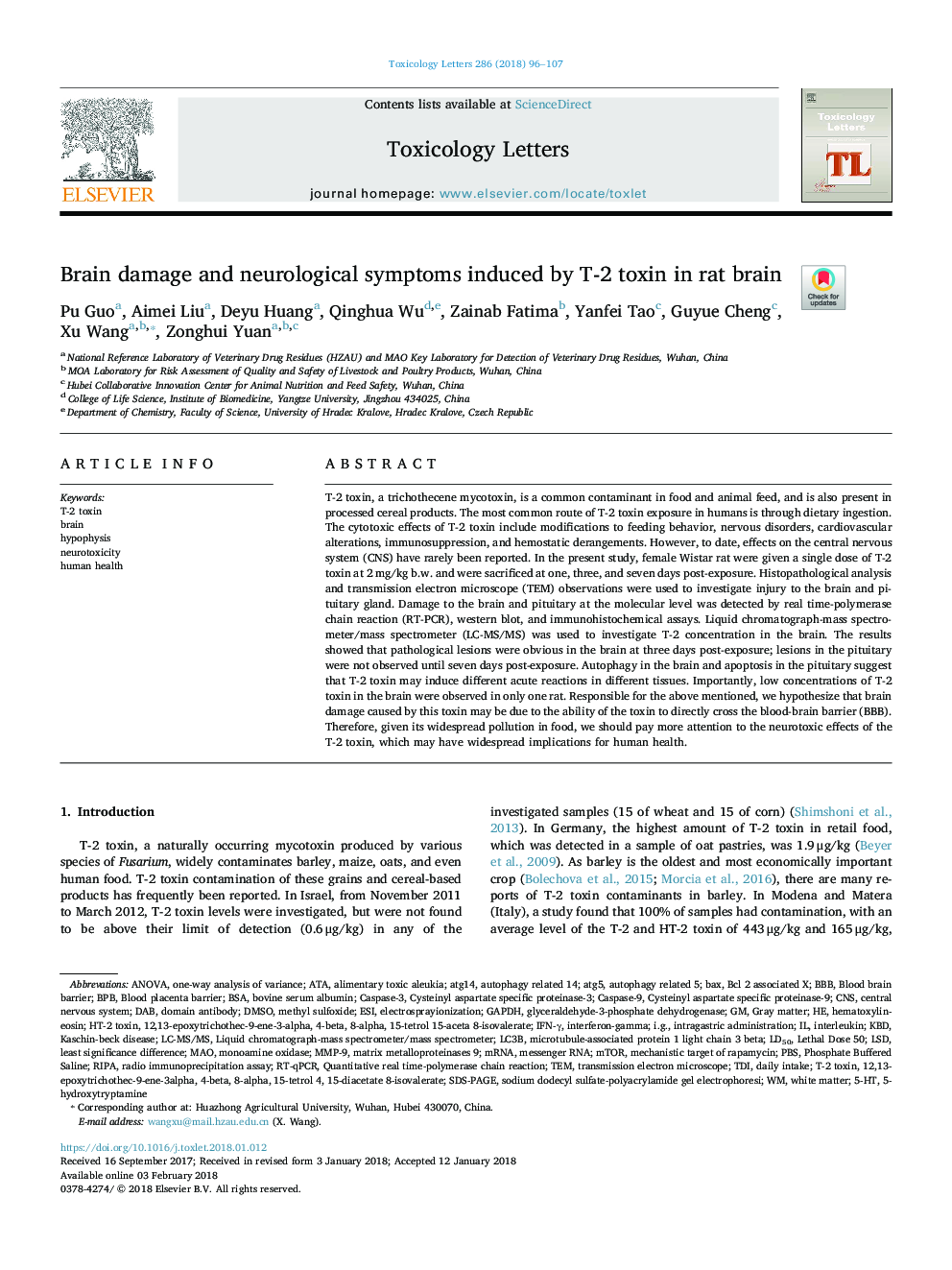| Article ID | Journal | Published Year | Pages | File Type |
|---|---|---|---|---|
| 8553415 | Toxicology Letters | 2018 | 12 Pages |
Abstract
T-2 toxin, a trichothecene mycotoxin, is a common contaminant in food and animal feed, and is also present in processed cereal products. The most common route of T-2 toxin exposure in humans is through dietary ingestion. The cytotoxic effects of T-2 toxin include modifications to feeding behavior, nervous disorders, cardiovascular alterations, immunosuppression, and hemostatic derangements. However, to date, effects on the central nervous system (CNS) have rarely been reported. In the present study, female Wistar rat were given a single dose of T-2 toxin at 2â¯mg/kg b.w. and were sacrificed at one, three, and seven days post-exposure. Histopathological analysis and transmission electron microscope (TEM) observations were used to investigate injury to the brain and pituitary gland. Damage to the brain and pituitary at the molecular level was detected by real time-polymerase chain reaction (RT-PCR), western blot, and immunohistochemical assays. Liquid chromatograph-mass spectrometer/mass spectrometer (LC-MS/MS) was used to investigate T-2 concentration in the brain. The results showed that pathological lesions were obvious in the brain at three days post-exposure; lesions in the pituitary were not observed until seven days post-exposure. Autophagy in the brain and apoptosis in the pituitary suggest that T-2 toxin may induce different acute reactions in different tissues. Importantly, low concentrations of T-2 toxin in the brain were observed in only one rat. Responsible for the above mentioned, we hypothesize that brain damage caused by this toxin may be due to the ability of the toxin to directly cross the blood-brain barrier (BBB). Therefore, given its widespread pollution in food, we should pay more attention to the neurotoxic effects of the T-2 toxin, which may have widespread implications for human health.
Keywords
5-HTBPbTDI5-hydroxytryptamineIFN-γRIPAMMP-9RT-qPCRMAOi.g.ATAmTORLC3BATG5GAPDHESIPBSAtg14DABLD50LSDKBDmRNAMatrix metalloproteinases 9BSADMSOHT-2 toxinLC-MS/MSmessenger RNARadio immunoprecipitation assaybovine serum albuminSDS-PAGETeminterferon-gammainterleukinBaxANOVAone-way analysis of varianceintragastric administrationLeast Significance DifferenceT-2 toxinDomain antibodyCNSlethal dose 50blood brain barrierBBBHuman healthNeurotoxicitycentral nervous systemPhosphate buffered salineGray matterwhite matterDaily intakeBrainmonoamine oxidaseTransmission electron microscopeMechanistic target of rapamycinhematoxylin-eosinHypophysisquantitative real time-polymerase chain reactionmicrotubule-associated protein 1 light chain 3 betaCaspase-3Caspase-9glyceraldehyde-3-phosphate dehydrogenase
Related Topics
Life Sciences
Environmental Science
Health, Toxicology and Mutagenesis
Authors
Pu Guo, Aimei Liu, Deyu Huang, Qinghua Wu, Zainab Fatima, Yanfei Tao, Guyue Cheng, Xu Wang, Zonghui Yuan,
